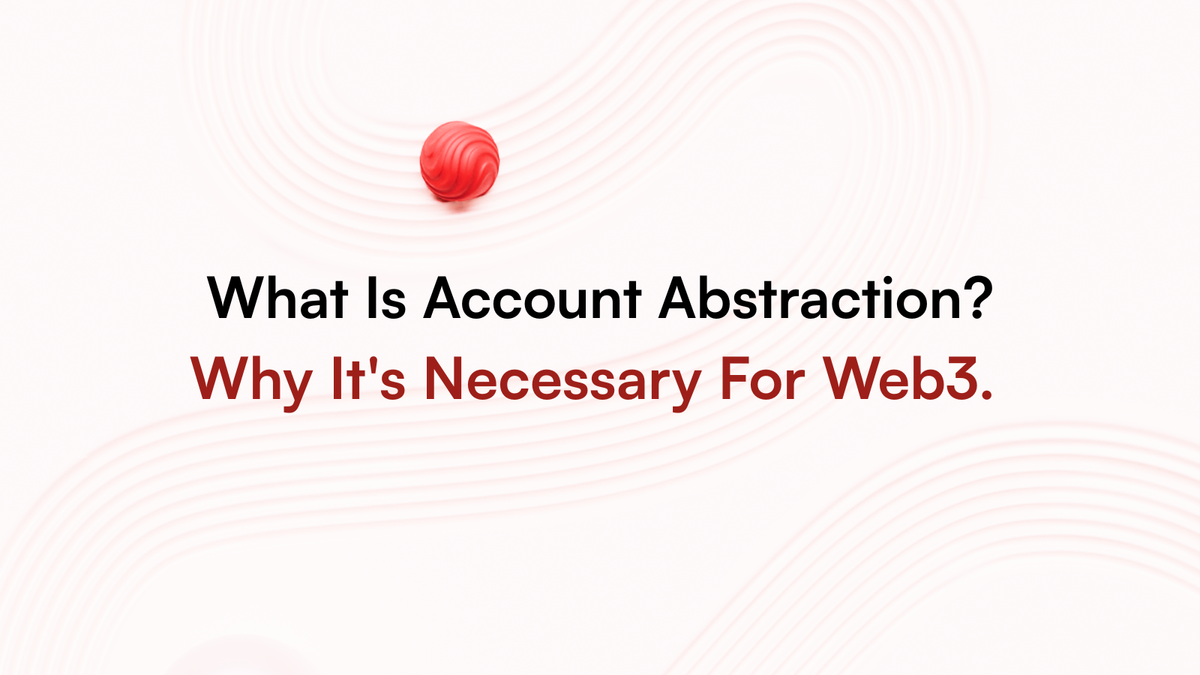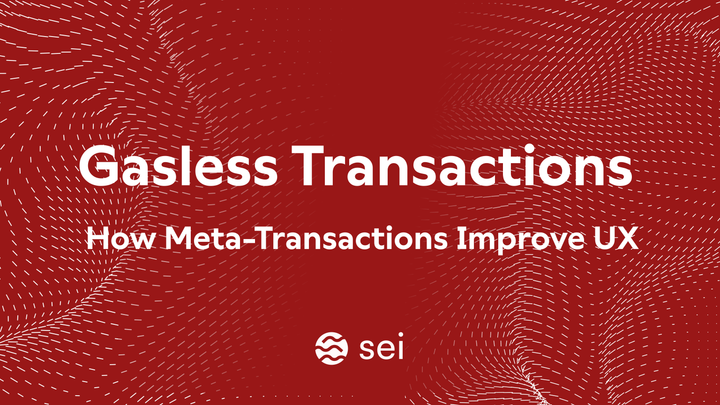What Is Account Abstraction? Why It’s Necessary For Web3

Managing private keys doesn’t come easily to people new to web3.
Users need to set up complicated wallets and keep their private keys secure to sign transactions when needed. However, it can become quite intimidating when users are required to sign transactions repeatedly whenever they’re trying to perform a task.
This is where account abstraction comes in to simplify things. It allows smart contracts to manage account operations. The complicated key management process becomes as simple as social logins or biometric verification.
In this article, we’ll take a deep dive into account abstraction while covering:
- What is account abstraction in web3?
- Understanding account abstraction in detail.
- How does account abstraction work?
- Account abstraction use cases
- Difference between traditional wallets and AA wallets
- Types of logic account abstraction facilitates
- Why is account abstraction necessary for web3?
- Comparing different web3 user experiences
Account abstraction smoother the web3 user experience, removing different barriers in scaling its adoption.
What Is Account Abstraction in Web3?
Account abstraction allows users to use smart contracts as their accounts. It empowers users to configure their own rules for wallet management instead of having a traditional account.
It alleviates all friction associated with web3 interaction. Blockchain users generally have an Externally Owned Account (EOA), which they operate using public and private keys. However, this creates friction for users when interacting with the dApp as they’re required to sign interactions constantly.
Account abstraction (AA) solves this. It makes a self-custodian crypto wallet easy to use, delivering the simplicity of Web 2.0 with the flexibility of web3. With account abstraction, you don’t have an externally owned address; you have a smart contract address, which is a smart contract with unique features. This smart contract holds your Ethereum Request for Comment (ERC)-20 tokens, Non-Fungible Tokens (NFTs), and a custom code specifying the transaction's conditions.
In this way, account abstraction abstracts the complexity of interactions with web3, improving the overall user experience.
This article will focus on the ERC-4337, a standard that implements account abstraction for EVM-bassed chains.
Understanding Account Abstraction In Detail
You have been reading a lot about how account abstraction improves the user experience. Here’s precisely what it improves. When you use a smart contract account, you have access to several possibilities. For example, wallet recovery, signless transactions, and team wallets. It ensures your web3 experience isn’t clunky.
Account abstraction was introduced as an update for Ethereum. Therefore, understanding Ethereum accounts is paramount to understanding its fundamentals.
An Ethereum account stores ether (ETH) on the blockchain and can initiate or execute transactions. These accounts can be externally owned accounts (EOA) or contract accounts. EOAs are outside a blockchain’s ecosystem. The most tricky part of EOAs is the seed phrase. A random string of 12, 18, or 14 is generated when setting up your wallet. This seed phrase is used to create the private key.
You need to store this key in a secure place offline. If you lose the private key, the seed phrase is the only way to reset it. Otherwise, you risk your assets.
These wallets are very common; the most popular crypto wallets are EOAs, such as Coinbase Wallet and MetaMask. On Ethereum, they’re a critical part of the ecosystem. A state transition happens only when an EOA triggers a transaction and pays the gas fees. However, they’re limited in terms of flexibility. They’re tricky to customize or automate. You need to sign every transaction and pay gas in ETH; you can’t use other tokens.
This is where contract accounts come in. You can configure these smart contracts with custom logic to add other features. However, these contract accounts don’t have a private key and cannot initiate a transaction. However, they execute a specific action when a transaction from an EOA triggers the smart contract code. However, users must maintain an EOA with an ETH balance to operate a contract account, making it more inconvenient than operating a standalone EOA.
This is when account abstraction does its trick.
How Does Account Abstraction Work?
Account abstraction creates independent, smart contracts. It initiates and executes transactions without the need for an externally owned account. These accounts use objects called UserOperations, which represent operations to be conducted on behalf of the user. They contain various elements, like the price for gas at different steps or signatures to validate, including other metadata.
Whenever UserOperation is triggered, it enters the shared waiting area called the alt mempool. The bundler, similar to nodes that verify transactions, bundles the request while prioritizing the more significant transactions in value. These bundle UserOperations are sent through a single whitelisted “Entry Point,” where every UserOperation is verified and executed by calling different functions.
Account Abstraction Use Cases
Below are some notable use cases of account abstraction.
- Configuring rules. Traditionally, if someone gets access to your private key, they might control the assets completely. However, account abstraction lets users modify what a private key can do, for example, signing transactions or limiting transfers.
- Eliminating the need to have the chain’s native token. You don’t need to fund an externally owned account, which would mean friction due to KYC and AML requirements. ERC-4337 puts up a paymaster that allows users to pay gas fees in any ERC-20 token or stablecoin.
- Introducing account abstraction. It lets users give third-party with access to automatically pull out a specific amount periodically. You don’t have to execute a transaction manually every time you send it.
- Creating batch transactions. DApps are often clunky, and the user is expected to approve multiple transactions to complete a task. With account abstraction, such transactions can be easily batched into a single approval workflow.
Differences Between Traditional Wallets and AA Wallets
In traditional wallets, the transaction is the basic unit of execution. These transactions are packaged into a block and added to the blockchain. On the other hand, in an account abstraction wallet, UserOperation or userOp is the basic unit. These UserOps enter a mempool, where they eventually get picked up for processing.
Here’s a quick overview of traditional and AA wallets based on their features:
Types of Logic Account Abstraction Facilitates
Different types of logic can be built into a smart contract wallet, for example:
Multisig Authorization
There are use cases where multiple authorities are required to sign a transaction to achieve the expected outcome. Account abstraction allows businesses to configure rules so that if a transaction is worth more than a preset amount, it requires most parties to sign it.
Multiple approvals can be required for such transactions, distributing the authority to sign translations to trusted authorities.
Account Recovery
If a device is lost or compromised, the smart contract wallet can be locked from any other authorized device. It saves your assets from being frozen forever. There is a provision with a smart contract wallet where a user can set up an allowlist.
It allows a smart contract to register new devices or reset access privileges of the old accounts.
Transaction Limits
You can set a daily threshold for how much value you can transfer from an account in a specific time period. The threshold can be a day, a week, or a month.
This prevents attackers from draining everything at once, even when they maliciously get access to the wallet. You have the opportunity to freeze and reset access.
Allowlists
Allowlists let a user transact with specified accounts only. Therefore, even if an attacker maliciously gains access to your account, they can transfer funds only to addresses that you know to be safe.
If an attacker were to change the addresses, they would require multiple signatures and backup keys, making the account more secure.
Why Is Account Abstraction Necessary For Web3?
Account abstraction removes the friction associated with gas management on Ethereum. Before AA, any transaction required users to pay gas in ETH. But you have USDC in the wallet. You won’t be able to swap it for ETH because that will cost gas. You might have to send more ETH to your account from an exchange or any other address to solve the block.
Account abstraction plays a creative role in gas management. It lets users pay a fixed fee to DEX for unlimited monthly transactions. DEX will pay the gas fees on your behalf, making it easier for you to interact with the smart contract wallet.
Account abstraction can provide a unified framework for account management across the web3 ecosystem. It facilitates cross-platform accounts that users can operate across various networks, saving users from the hassle of managing different accounts. It’s useful for applications that span multiple blockchain networks.
Overall, this adds great value from a UX standpoint. Users get a more cohesive experience while navigating web3, improving the overall utility of their applications.
Comparing Different Web3 User Experiences
Let's highlight the different UX types people get while navigating the web3 ecosystem.
- Interaction with a traditional dApp. Users need to download a wallet like MetaMask or a mobile wallet and then fund the wallet with gas money before using the dApp. They would also need the right on-ramp for converting fiat to crypto. Finding a reliable service is an extra step. Once these things are figured out, users will manually sign transactions and pay gas fees. However, this process creates an entry barrier for new users.
- Gasless transactions through account abstraction. In such transactions, users need a wallet, but their gas fees are already covered. Instead, they sign a UserOperation. Such transactions reduce complexity and improve user experience significantly.
- Web2 login and account abstraction. This is helpful for people interacting with web3 for the first time. It delivers Web2-style login and authentication. The wallet and gas transactions are handled in the background. One-click is all it takes to make transactions.
Exploring Abstraction in Sei Sei incorporates gas abstraction, empowering users to pay fees in any token, not just SEI. Through embedded smart contract logic, developers can apply granular control over transaction behavior. This includes whitelisting specific protocols, enforcing spending limits, or requiring multiple signature approvals for critical operations, all within a user-friendly framework.
Dynamic powers Sei’s Global Wallet, enabling users to onboard quickly and pay gas fees in multiple tokens. By abstracting the wallet experience, Dynamic helps make Sei’s application layer feel familiar, fast, and intuitive even for users new to crypto.
These integrations are helping Sei deliver a streamlined, developer-first environment where users benefit from the power of Web3 without needing to understand its complexity. Abstraction is no longer a theoretical goal. It’s live, operational, and shaping the user experience on Sei today. From wallet UX to gas and cross-chain messaging, Sei’s growing ecosystem is making blockchain feel invisible. That’s not just a win for developers. It’s a step toward unlocking the next wave of mainstream adoption.



